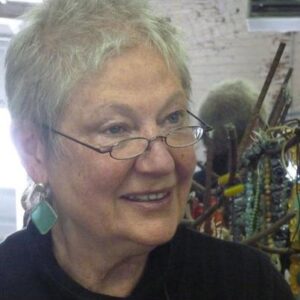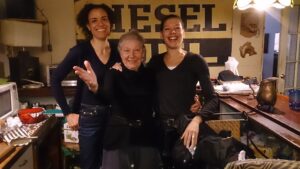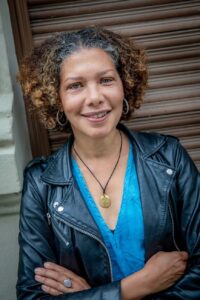Episode 217
What you’ll learn in this episode:
- How Saudia is preserving her mom Cara Croninger’s legacy
- Why Cara Croninger’s resin and plastic jewelry was—and still is—groundbreaking
- How Cara Croninger refined her jewelry making process, and why she didn’t want her pieces to be perfect
- What it was like to grow up in an artistic family in the heyday of New York’s art jewelry scene
- How Saudia’s mom and dad influenced her music career today
About Saudia Young
Saudia Young is a New York City-born actress/singer and storyteller in theater and film. Born on the Lower East Side and brought up between Tribeca and LA, Young explores the notion of home, love, justice, and identity through her art.
The recently repatriated artist lived in Berlin, Germany, for a long chapter of performing, writing, and producing. The Ameripolitan Awards 2023 Female Rockabilly Singer nominee released her 7″ single ‘Noir Rockabilly Blues,’ produced by Lars Vegas-DE and featuring ‘The Wobble’ on the A and Iggy Pop’s ‘Lust for Life’ on the B side, in 2017, followed up by her 12” debut ‘Unlovable’ in 2018. The LP was recorded live at Berlin, Germany’s legendary Lightning Recorders.
Young founded a Dark Kabarett and a Rockabilly Noir Blues band in Berlin, co-created the Lost Cabaret and the Schwarze Liste Kabarett theater projects and wrote and produced the award-winning short film The Gallery. While in Berlin, she was cast in the lead voice-over role of Oskar in School for Vampires (the English version of the Hahn Film cartoon series).
Young co-wrote and performed the solo show Sneaker Revolution and is currently writing a theater/film piece about her actor father, Otis Young, and sculptor/designer mom Cara Croninger.
Photos:






Additional Resources:
Transcript:
To jewelry lovers, Cara Croninger was a groundbreaking artist whose work was shown at iconic galleries Artwear and Sculpture to Wear. To musician and actress Saudia Young, she was just mom. Today, Saudia is working to preserve her mother’s legacy and secure her place in art jewelry history. She joined the Jewelry Journey Podcast to talk about how Cara made her pioneering resin jewelry; how Cara’s work evolved with the times; and why Saudia thinks of her mom every time she performs. Read the episode transcript here.
Sharon: Hello, everyone. Welcome to the Jewelry Journey Podcast. This is the second part of a two-part episode. If you haven’t heard part one, please head to TheJewelryJourney.com.
Today, we’re speaking to my guest, Saudia Young, who is located in Philadelphia. She has an interesting background. Her mother was a very well-known jeweler, and her father was an actor. She was born in New York and grew up between New York and Los Angeles. Welcome back.
Were you aware she was doing this? Were you aware that she went to different galleries, that she didn’t have a sales rep when you were growing up? Were you aware of this?
Saudia: Yeah, of course. There was one point in the 90s where she had a showroom. Tony Goldman and Janet Goldman had a showroom called Fragments, and she was in the showroom for some years. She had different reps throughout her life. Ten Thousand Things was a store. They still exist, and they have incredibly beautiful work. For a while in the Meatpacking District, they had a nice cadre of artists, and my mom was one of the artists. They also did wholesale for her. So, they represented her work to other people.
Sharon: I have a few pieces, just a smattering, but do you have a lot of her work? Do you have an archive of her work?
Saudia: Oh, yeah. That’s part of what I’ve been dealing with. My sister and I have our own personal collections. Throughout the years, my mom collected the best pieces of each group and gave us our personal collections. Then I have basically all the work she left behind when she passed away. I’ve been trying to organize that. There was a big section of it shown at the Aspen Art Museum two years ago for about a year. Jonathan Burger had a show called The Store. My mom’s jewelry and sculptures were in one show. That was really exciting, to have both together. Actually, 14 small sculptures sold during that show and, fingers crossed, about seven pieces will be donated to an institution. I’m not going to say which one. That takes a long time.
Right now, there are pieces that are actively being sold. Lisa Berman—not a family member, just the same last name—from Sculpture to Wear sold some of my mom’s work at her first gallery. She also helped sell some pieces when I came out and was trying to figure out what to do and how to secure the legacy, meaning literally a storage space to hold everything. It’s a big responsibility.
Sharon: You’re referring to Lisa Berman.
Saudia: Yeah, who is not your blood relation but of the same name. Obviously, she introduced us and was part of the first interview. She’s consulted with me. She’s another one of the angels. There’s a whole host of people who are still in awe of my mom’s work and in support and cheerleading. It includes Robert Lee Morris.
I’m still trying to figure out what to do with the work to secure the legacy. It is being sold at Studio Hop in Providence, Rhode Island. That’s introducing the work to some people who have not seen it before. It’s introducing it to a new audience, which is really nice. Jussara Lee, who used to sell it in Manhattan and is now in Connecticut, has been selling it. Other than that, I have an Artwork Archive website for her so people can see the work. I’m not selling it from that website, but there is a section of it that’s still being sold. Then there’s a section I’m holding in case I can get it accepted into an institution.
Sharon: I remember a few years ago, I fell in love with a bracelet and I didn’t end up getting it. I think it was the first time I ever heard of her, and I thought it was so neat.
Saudia: Yeah, it sold a lot of work. They stopped selling after she passed away. They also had a hard time. Everybody is just recovering now from Covid. A lot of people had a very hard time in the past few years. Some stores closed and sales went down. There were several stores who were carrying her work who have closed since Covid.
Sharon: What did you do to make it through Covid and to have money come in?
Saudia: I cried. I don’t know. I did whatever I could. I was going back and forth between Germany and here. There was a grant in Germany—actually, it wasn’t a grant; it was a loan—but there was a Covid loan they were giving to artists in Germany. Here, I went on unemployment for a while and then I went off it, whatever I could. We all did what we could to survive.
Sharon: That’s very true. I know there were different things we had to do. I agree with you that people are just coming out of it now.
Saudia: And now we have two wars, so it’s like, “Great, thank you.” Can’t catch a break.
Sharon: Which is worse? I don’t know. I guess if you’re in the field over there, it’s worse.
Saudia: Yeah.
Sharon: A lot worse. How does it feel to have a mother who’s mentioned by people you don’t know? You say you’re the daughter and all of a sudden, they say, “Oh, I love your mom,” or “I love her jewelry.”
Saudia: What do you mean? How does it feel?
Sharon: Yeah. If I said, “Oh, I have a really neat bracelet,” and the person says, “I’ve not heard of that person,” how does it feel?
Saudia: First of all, a young man—he’s probably my age. It’s so funny I still think of myself as a teenager. Timothy Reukauf is a stylist. He’s another angel who introduced me to the manager and owner of Screaming Mimis Vintage clothing and jewelry store in New York. When I brought the work, because they brought the work to a vintage show, and they’re showing the work and trying to sell it, she was so enthusiastic and happy and excited. It was nice because it’s an extension of my mom, and I miss my mom. I feel like it’s that, as opposed to anything ego-based. It’s more emotional—now you’re going to get me emotional. But it’s nice to know because I really miss her, and when I hear people loving her work, it’s heartening. It’s heart filling.
Sharon: That’s a good word, heart-filling. I’ve heard different things. It’s Croninger with a hard g. I’ve heard that as Croninger with a soft g. Which one is it?
Saudia: Oh lord, that’s a good one. It’s Cara Croninger with a hard g, but people have called her Croninger with a soft g. People have called her Cara. She’s even called herself Cara, but it’s Cara Lee. Her Michigan name was Cara Lee Croninger, but it depends on who you are. Are you Dutch? Are you German? Are you from New Jersey?
Sharon: Did she support your career as an artist?
Saudia: Do you mean my dreaming? Yeah, she supported me being a dreaming, silly person, definitely. She put me in dance school. She always thought I should be a painter, actually. She’d say, “You should be a painter,” because I had a natural ability to draw and to work with my hands. After being a child laborer with her, I could make things. But all jokes aside, she was very supportive of me being an artist or whatever it was that I wanted to be, political activist or artist. My sister was an architect. She was very supportive of that. She was beloved by a lot of the young artists who were around Dumbo, our friends, our extended family. She was a positive influence, a positive auntie, elder, second mom, to a lot of people.
Sharon: It sounds like it.
Saudia: Yeah. I shared her as a mom figure with a lot of people.
Sharon: Tell us more about your singing. Do you think of her when you sing?
Saudia: Yeah, I think of her with whatever I do, for sure. There’s one song—I think you wrote it down on the question list—It Don’t Mean a Thing (If It Ain’t Got that Swing), doo wop, doo wop, doo wop, doo wop. I think it was Louis Armstrong. She was working on some kind of saying or branding because she was really into the earrings having a nice swing. She coined it when I was helping her make them. The holes had to be big enough so the lyre could be comfortable enough so the earrings could swing. She incorporated that into some of her branding.
But yeah, I listened to a lot of music growing up. She was very into Judy Collins and Kurt Weill, a wild range. She dated one of the Clancy Brothers—they were very into folk music in the 60s—and my dad and her were into soul and Otis Redding and Taj Mahal and Bonnie Raitt. I’m wandering, but yes.
Sharon: What years was she most popular? It seems like she had a real high.
Saudia: I think the 80s. The minute she started doing the resin stuff, she went into Sculpture to Wear, which was a very prestigious gallery. I’d say the early 70s through the 80s. Then Artwear closed and she was on her own. She did really well in the 90s as well. She was pretty prolific, but I think the 80s were the time when there were tons and tons of fashion articles and fashion shoots with all the supermodels of that time.
Sharon: Talk about wandering, because I’m looking at my list of questions. Tell us how you were involved in making her jewelry. You told us a little bit, but did you ever cut the hearts?
Saudia: The hearts were made in molds. She created molds and poured, and then we would open the rubber molds. I would help sand. I would help drill holes. I can drill a hole. I would help with polishing. Like I said, I would help with finishing work and stringing cords on the hearts. Trying to influence her businesswise, she was not having it.
Sharon: Would she say, “That color doesn’t look better in the green. It looks better in the purple,” or something that?
Saudia: No, not really because once something is poured, it’s a done deal. That would be like, after you’ve made 500 brownies, saying, “I wish we had blueberry muffins.” It’s too late now.
Sharon: She could say, “Well, you can have it then, and I’ll try and sell the purple one,” or something.
Saudia: No, the work was too labor-intensive. Once things were made, you really needed to get them out there. They were like donuts in a way. You need to get them out so they don’t go stale. Keep the energy, keep them moving. The only thing she was conflicted about was pricing. There was a point in jewelry where everything—remember when the Y necklaces came out? Everything was really tiny. There was a point where it was trendy to have really tiny jewelry, and that freaked her out because her work was so big and sculptural. She would get freaked out about that kind of stuff. The editors loved her work because it was big and you could see it. It went incredibly with beautiful clothes like Issey Miyake and these avant garde designers. The tiny stuff, you can’t see it in an editorial. It’s so funny; you’ll have a cover article and it’ll be like, “Earrings by whomever,” and I’m like, “Where are they? What earrings?”
Sharon: That’s interesting. Miyake or Yohji Yamamoto, they’re high-end, but they’ve become very—they’re not that valued anymore.
Saudia: Now they’re mainstream, yeah.
Sharon: Do you think your mother’s jewelry would be considered avant garde today?
Saudia: Yeah, it still is in a way because of the designs and the fact that it was really handmade. She was making her own work. Maybe Lisa would call that studio jewelry. She was in her studio making it herself. She did have a short relationship with a company in Japan where they were making work that would only be sold there. It was fine, but you could really see the difference and feel the difference. It wasn’t Cara. It wasn’t special, unfortunately. We’re grateful that they did it, that she had that relationship and that we could go to Japan and travel there. That was awesome.
So, I think she was avant garde as an artist. I don’t agree that Yohji is no longer avant garde. His designs are so beautiful. He’s really focused on craftsmanship, having amazing makers creating his work. In a way that is avant garde, as opposed to crap being made. You know what I mean?
Sharon: You’re right, 100%.
Saudia: In a factory.
Sharon: I can’t think of another one, but there are a lot of designers whose work you can’t afford—I’m talking about clothing—who have developed their own less expensive lines.
Saudia: Yeah. I remember when they would call it the junior line, and it would be for the younger kids. It would be lighter and cheaper and faster and funnier and all that. Now there are lots of layers of that, but you have these throwaway clothes being made by companies like H&M and so forth.
Sharon: Do you think she would fit in, like she’d make a smaller version of something that she made large?
Saudia: She did do some smaller things when she was working with the Japanese company. That led her into making some tiny silver hearts and medium-size silver. Then she had to do her big pieces. She could not let go of her love affair with big, sculptural pieces. I think she was conflicted about the McDonaldizing of fashion and accessories. Of course, she wanted to put food on the table, but she was really conscious of the environment. Even though she was working in plastics, she was very conscious of workers and workers’ rights. Where does something come from? How is it made, and what’s the impact of it being made?
Sharon: It sounds like she carried that through the 80s, into the 90s, into today.
Saudia: Definitely. She definitely had something to do with me being political, her and my father. She was very righteous.
Sharon: I know you do cabaret and rockabilly. What else do you do? What do you sing?
Saudia: My main focus is mental health. It’s a really hard time right now, I feel, but I think it’s actually a good time to continue to do the rockabilly, but to circle back to the dark cabaret I was doing before the rockabilly. So, I’m working on that. I’m working with a few musicians here in Philly, and I have some shows with musicians in other parts of the country. For Thanksgiving, I’m going to be in Illinois with Patrick Jones and 3 On The Tree. It’s a band. We’re going to do a rockabilly Thanksgiving tour. Then in March, I’ll be in California, in Orange County.
Sharon: Doing what?
Saudia: Doing rockabilly with The Hi-Jivers and Abby Girl. In Orange County, we’re going to do just a rockabilly R&B show. Then in April, I’ll be with Viva Las Vegas again, which is a rockabilly weekend. I’ll do an R&B show and rockabilly. In between, I’m just trying to stay sane, make a living, take care of my mom’s work, tell her story. I’m supposedly writing a story about my mom and my dad, sort of a solo show. I don’t know if it’s a solo show or a documentary, but it’s about their relationship as an interracial couple in the 60s and an interracial artist couple.
Sharon: That’ll be very interesting
Saudia: They were both known as being difficult people, but most artists are in a way. It takes a lot of energy to do that work, so you can ruffle a lot of feathers. So, that’s what I’m doing.
Sharon: I hope I’ll get to meet you then. Thank you so much. This was very interesting.
Saudia: Thank you so much.
Sharon: Thank you. Well will have photos posted on the website. Please head to TheJewelryJourney.com to check them out.
Thank you again for listening. Please leave us a rating and review so we can help others start their own jewelry journey.

